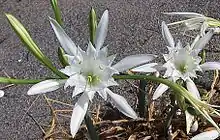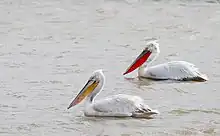Kızılırmak Delta
The Kızılırmak Delta (Turkish: Kızılırmak Deltası) is the delta of the Kızılırmak River, 40 km east of Samsun.[2] It is the biggest wetland in the Black Sea Region[3] and is one of several internationally important[4] Ramsar sites in Turkey on account of its rich bird and plant life.[5] There is a bird reserve.
| Kızılırmak Delta | |
|---|---|
| Kızılırmak Deltası | |
 The delta from a bridge over the river | |
 | |
| Location | Bafra, Samsun Province |
| Coordinates | 41°36′N 36°05′E |
| Website | samsun www www |
| Official name | Kizilirmak Delta |
| Designated | 15 April 1998 |
| Reference no. | 942[1] |
Almost half the land is used for farming,[6] with all of the first and second delta plains and most of the third delta plain dominated by agriculture.[7]
Geography
The Kızılırmak is the longest river entirely within Turkey and has the second largest drainage basin.[2]
The delta covers an area of about 56 thousand hectares of which 16,110 are wetland.[8] Although the coast had been expanding[9] it is now retreating, mainly due to less sediment coming down the river due to dams built upstream.[10][11]
Lakes
There are over 20 lakes,[2] which average 1.5m deep but double that in spring.[8] Balık Lake is brackish but the rest are freshwater.[8] Some of the lake water is eutrophic due to agricultural pollution.[12]
Geology
A canyon cut into the previous delta platform during the Last Glacial Period has filled.[13]
Ecosystems
In the delta are many wetland ecosystems: bottomland hardwood forest, freshwater and brackish lakes, reed beds and sand dunes. There is also broadleaved woodland and farmland.[2]
Birds
70% of bird species in Turkey have been recorded and the delta is important for birds which directly cross the Black Sea.[18] White stork breed here[19] and there are many other species such as: grey-headed swamphen and great white egret. There is a bird ringing station called Cernek Ringing Station.[20] At Ondokuz Mayıs University there is a bird research center,[21] which has ringed 165 thousand birds from 175 species in the delta.[22]
Reptiles
Reptile species found in the delta are Greek tortoise, European pond turtle, Darevskia saxicola lizard, European green lizard, Balkan green lizard, slow worm, European cat snake, Caspian whipsnake, grass snake, dice snake, and horned viper.[23]
Amphibians
Of the nine species of amphibians found in the delta, two species are salamanders and seven species are frogs. The main species in the area are the southern banded newt (Triturus vittatus), southern crested newt (Triturus karaelinii), common toad (Bufo bufo), European green toad (Bufo viridis), European tree frog (Hyla arborea), eastern spadefoot toad (Pelobates syriacus), agile frog (Rana dalmatina), and Uludağ frog (Rana macrocnemis).[23]
Threats
A 2020 study found both sewage and agricultural pollution in the channels.[25] Gendarmes are stationed to prevent illegal hunting.[26] Pumping of groundwater causes seawater intrusion,[27] and in 2021 academics called for such pumping to be stopped.[28] Climate change in Turkey has changed bird migrations.[18]
Management
One of 14 Ramsar sites in Turkey covers 21700 hectares.[29] Some traditional practices help with the management: for example water buffalo and fishing boats help keep the connections between the lakes open.[30] In the late 2010s experts issued a management plan although they could not agree with residents what should be done;[11] as the existing management plan runs to the end of 2023 a revised plan is being discussed.[31]
Agriculture
The land is one of the most fertile plains for agriculture in Turkey. There are more buffalo than anywhere else in the country. The most important crop is rice,[2] but some say it uses too much water which is needed for nature or buffalos.[11]
History

Strabo described the delta as producing fruit,[33] deer,[33] gazelles and soft-wooled sheep,[34] and the town of Gadilon. During the Ottoman Empire and early years of the republic malaria was widespread near the marshes and the lower lands were occupied seasonally.[11] As in some other parts of the country much of the population was forcibly exchanged between Greece and Turkey in the early 20th century.[11] Malaria hindered attempts to resettle migrants from lands lost by the empire, and during the 20th century some of the land was drained to combat mosquitos and provide agricultural land for these people and those coming from the eastern Black Sea part of Turkey.[11] Rice production was expanded.[11]
Tobacco was a major crop on the higher lands[11] and there is a tobacco museum in Bafra.[35]
Festivals included a stork feast, spring release of water buffaloes, and sheep breeding.[30] Traditionally it is considered sinful to kill certain animals and plants always or at certain times of year.[30]
In the late 20th century the ecological value of the marshes was recognized and attempts to protect them began, although some local residents opposed restrictions on agriculture and building.[11] At the end of the 20th century they were made a Ramsar site, then nature tourism became popular,[11] and in 2016 they were inscribed in the tentative list of World Heritage Sites in Turkey.[2]
References
- "Kizilirmak Delta". Ramsar Sites Information Service. Retrieved 25 April 2018.
- "Kızılırmak Delta Wetland and Bird Sanctuary". UNESCO World Heritage Centre. Retrieved 2019-03-14.
- "38 Black Sea wetlands to visit" (PDF). Archived from the original (PDF) on 2014-04-14.
- "Ramsar Sites of Turkey".
- "Kızılırmak Delta". Doğa. Retrieved 2023-02-21.
- "The Journal of Academic Social Science Studies". jasstudies.com. Retrieved 2023-10-02.
- Ozesmi, Uygar (2006). "Ecosystems in the Mind: Fuzzy Cognitive Maps of the Kizilirmak Delta Wetlands in Turkey". arXiv:q-bio/0603022.
- Burak, Zinet; Gazi̇oğlu, Cem; Müftüoğlu, Ahmet. Geomorphological features of Kızılırmak Delta.
- Yılmaz, Cevdet (2007). "Bafra Ovası'nın beşeri ve iktisadi coğrafyası". kutuphane.tarimorman.gov.tr (in Turkish). Retrieved 2023-10-02.
- Alpar, Bedri (2009-06-01). "Vulnerability of Turkish coasts to accelerated sea-level rise". Geomorphology. Coastal vulnerability related to sea-level rise. 107 (1): 58–63. Bibcode:2009Geomo.107...58A. doi:10.1016/j.geomorph.2007.05.021. ISSN 0169-555X.
- Scaramelli, Caterina (August 2018). ""THE WETLAND IS DISAPPEARING": CONSERVATION AND CARE ON TURKEY'S KIZILIRMAK DELTA". International Journal of Middle East Studies. 50 (3): 405–425. doi:10.1017/S0020743818000788. ISSN 0020-7438.
- "Ramsar Information Sheet" (PDF). Ramsar Convention. December 2007.
- Ertunç, Gülgün (2016-11-25). Paleoenvironmental interpretations for Kizilirmak Delta Plain using Sedimentological records, Multiproxy Analysis And Palynology (Thesis). Eurasia Institute of Earth Sciences. hdl:11527/16883.
- "Kuraklık eylemi planı" [Drought action plan] (PDF).
- "Soil Geographical Database of Turkey at 1:1,000,000 scale" (PDF).
- Natural Protected Areas of the Wetland and Bird Paradise in the Kizilirmak Delta in Samsun: 2019-2023 Management Plan (PDF) (Report). Environment Ministry.
- "Kızılırmak Delta Wetland and Bird Sanctuary". Archiqoo. Retrieved 2023-05-11.
- "Küresel ısınma Kızılırmak Deltası'ndaki kuş varlığını da değiştirdi".
- Yavuz, Kiraz Erciyas; Yavuz, Nizamettin; Tavares, José; Barış, Y. Sancar (2012). "Nesting habits and breeding success of the White Stork, Ciconia ciconia, in the Kızılırmak delta, Turkey". Zoology in the Middle East. 57: 19–26. doi:10.1080/09397140.2012.10648959. S2CID 87042198.
- Özkoç, Ömral Ü; Oğuz, Deniz; Nacar, Can; Erciyas-Yavuz, Kiraz; Barış, Y. Sancar (2020-01-02). "Red-flanked Bluetail Tarsiger cyanurus recorded at the Turkish Black Sea coast for the first time". Zoology in the Middle East. 66 (1): 91–93. doi:10.1080/09397140.2020.1711629. ISSN 0939-7140. S2CID 213663552.
- "Ornitoloji Araştırma Merkezi". ornitolojiarmer.omu.edu.tr. Retrieved 2023-05-17.
- "OMÜ Ornitoloji Araştırmalar Merkezi'nden Kızılırmak Deltası'nda 165 Bin Kuş Halkalandı" [165 Thousand Birds Ringed in the Kızılırmak Delta from OMÜ Ornithology Research Center]. Son Dakika (in Turkish). 2023-05-10. Retrieved 2023-05-17.
- "Kızılırmak Deltası, Kuş Cenneti ve Mandacılık" [Kızılırmak Delta, Bird Sanctuary and Buffalo Farming]. Samsun Governorate.
- "Biological Data Derived from Sturgeon (Acipenser stellatus, Acipenser gueldenstaedtii and Huso huso) by-catch along the Coasts of the Southern Black Sea (Turkey)" (PDF). Turkish Journal of Fisheries and Aquatic Sciences.
- Şener, Şehnaz; Şener, Erhan; Varol, Simge (2020-11-01). "Hydro-chemical and microbiological pollution assessment of irrigation water in Kızılırmak Delta (Turkey)". Environmental Pollution. 266 (Pt 1): 115214. doi:10.1016/j.envpol.2020.115214. ISSN 0269-7491. PMID 32688111. S2CID 220671466.
- "Kızılırmak Deltası'nı, atlı jandarma timi koruyor" [Mounted gendarmerie team guards the Kızılırmak Delta.]. Hürriyet (in Turkish). 22 June 2018.
- Ersoy, Arzu Fırat; Turan, Nazlı Ayyıldız; Özgül, Hava Yıldız (2020-10-15). "Kızılırmak Delta Kıyı Alanındaki Tuzlanma Sürecinin Stuyfzand Hidrojeokimyasal Modelleme Sistemi ile Değerlendirilmesi" [Evaluation of Salinization Process in Kızılırmak Delta Coastal Area with Stuyfzand Hydrogeochemical Modeling System]. Gümüşhane Üniversitesi Fen Bilimleri Dergisi (in Turkish). 10 (4): 949–960. doi:10.17714/gumusfenbil.727322. ISSN 2146-538X.
- Ersoy, Arzu; Turan, Nazli; Arslan, Hakan; Kuleyin, Ayse (2021). "Assessment of seawater intrusion in Kızılırmak delta coastal area (North Turkey) using hydrochemical and isotopic data". Environmental Earth Sciences. 80 (11): 400. Bibcode:2021EES....80..400F. doi:10.1007/s12665-021-09700-9. ISSN 1866-6280. S2CID 235128048.
- "Ramsar Alanlarımız" [Our Ramsar sites] (PDF).
- Gül, Seyfullah (2020). "Kızılırmak Deltasında Yazılmamış Kanunlar: Bir Sulak Alanın Korunmasında Geleneksel Ekolojik Bilginin Rolü". International Journal of Geography and Geography Education. 25 (42): 321–324. ISSN 2630-6336.
- "Kızılırmak Deltası Sulak Alan Revize Yönetim Planı Çalıştayı Gerçekleştirildi". ABC Haber (in Turkish). 2023-09-20. Retrieved 2023-10-02.
- "The Perspectives of Local Residents on the Rural Tourism: the case of Samsun Kizilirmak Delta".
- "Strabo, Geography, BOOK XII". www.perseus.tufts.edu. Retrieved 2023-10-02.
- "LacusCurtius • Strabo's Geography — Book XII Chapter 3". penelope.uchicago.edu. Retrieved 2023-10-02.
- "Bafra Tütün Müzesi". samsun.ktb.gov.tr. Retrieved 2023-05-11.
Further reading
- Natural Protected Areas of the Wetland and Bird Paradise in the Kizilirmak Delta in Samsun: 2019-2023 Management Plan Environment Ministry
- Scaramelli, Caterina (2021). How to Make a Wetland: Water and Moral Ecology in Turkey. Stanford: Stanford University Press. ISBN 978-1-5036-1385-0.
External links
![]() Media related to Kızılırmak Delta at Wikimedia Commons
Media related to Kızılırmak Delta at Wikimedia Commons

